成为孔子旅游使者,感受山东非遗魅力
Be the Confucius Tourism Envoys for the Glamorous Intangible Cultural Heritage of Shandong Province
文化是自然造化与人类智慧的完美结晶,非物质文化遗产是人类世代相承、与生产生活密切相关的各种传统文化的表现形式。
Culture is a perfect crystallization of the nature’s power and human wisdom, while intangible cultural heritage is a manifestation of various traditional cultures that are inherited from generation to generation and closely related to production and life.
中国山东省是非物质文化遗产大省,非物质文化遗产数量庞大,种类繁多。截止2020年4月,中国山东省共有联合国教科文组织认定的“人类非遗代表作名录”项目8个,国家级非遗名录173项,省级非遗名录751项,市级非遗名录3700多项;现有国家级非遗传承人90多名,省级非遗传承人440多名,市级非遗传承人2200多名;国家级文化生态保护区1个,省级文化生态保护实验区10个。
Shandong Province of China is home to a large number and rich variety of intangible cultural heritage. As of April 2020, Shandong had eight items inscribed on the UNESCO’s Representative List of the Intangible Cultural Heritage of Humanity, over 170 on the national list, some 751 on the provincial-level list, and 3700-plus on the municipal-level list. Moreover, the province boasts 90-plus representative inheritors of intangible cultural heritage at the national level, over 440 at the provincial level and more than 2,200 at the municipal level. In addition, there is one national-level eco-cultural preservation area and ten provincial-level experimental zones for eco-cultural preservation in the province.
祭孔大典
Confucius Memorial Ceremony
祭孔大典是山东省曲阜专门祭祀孔子的大型庙堂乐舞活动,是集乐、歌、舞、礼为一体的综合性艺术表演形式,形象地阐释了孔子学说中“仁”“礼”的涵义,体现了艺术形式与思想内容的高度统一,集中表现了儒家文化,于每年阴历八月二十七日孔子诞辰时举行。2006年列入《第一批国家级非物质文化遗产名录》。
The Confucius Memorial Ceremony is a large-scale performance involving music and dance at a temple to worship Confucius in Qufu of Shandong Province, the hometown of Confucius. It’s a comprehensive art performance that integrates music, singing, dancing, and rites. It vividly interprets the meaning of the concepts of “Ren” (benevolence) and “Li” (propriety) in Confucianism, represents the high degree of unity of artistic form and ideological content, and epitomizes the Confucian culture. It is held every year on August 27th of the lunar calendar, the birth date of Confucius. In 2006, it was inscribed on the First Representative List of State-Level Intangible Cultural Heritage in China.
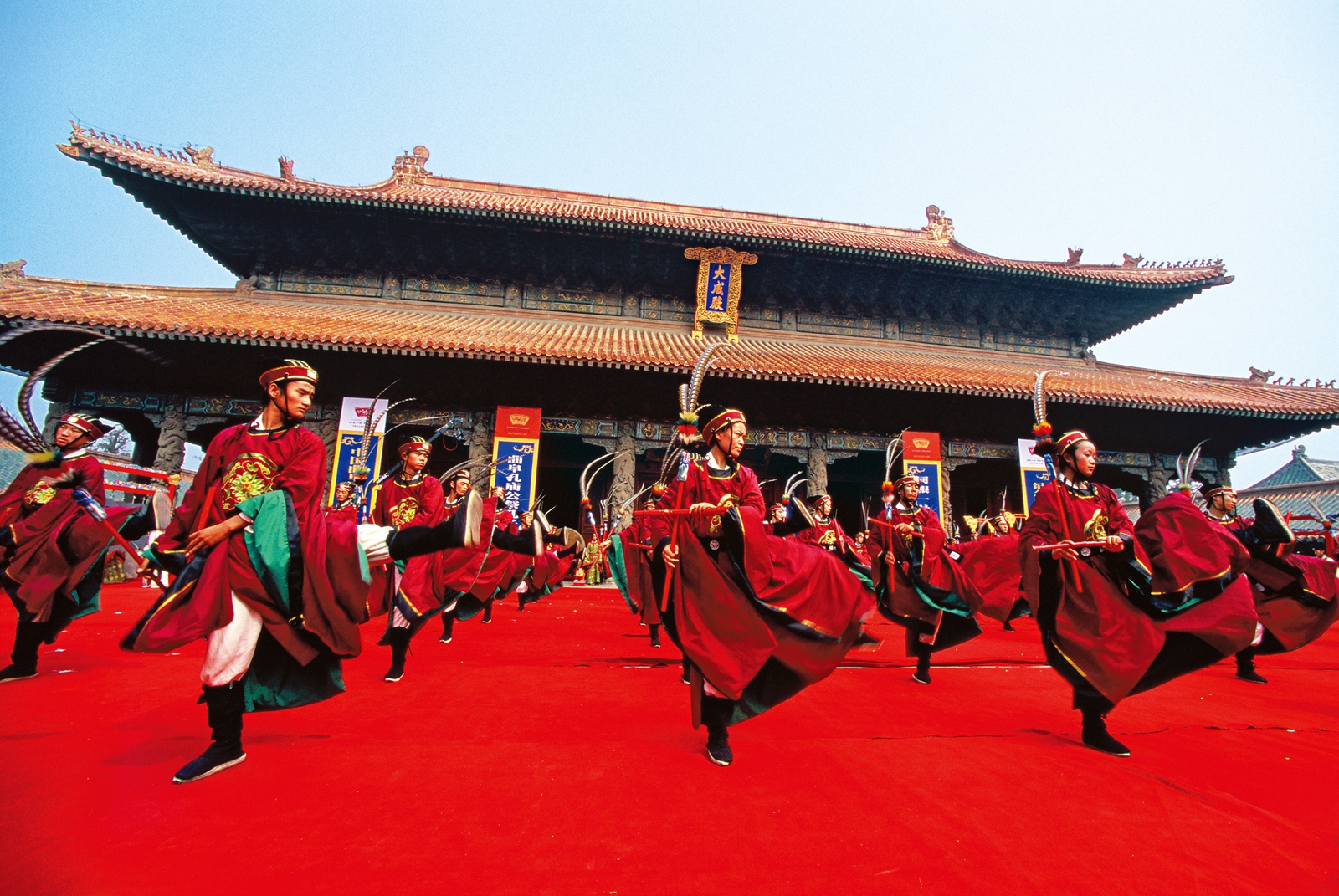
吕剧
Lv Opera
吕剧起源于山东北部黄河三角洲的东营市,流行于山东以及江苏、安徽的部分地区,是山东省的代表性剧种。吕剧由民间说唱艺术“山东琴书”发展演变而来,主要乐器是坠琴、扬琴、三弦、琵琶等“吕剧四大件”。吕剧的创作源于生活,具有浓郁的乡土气息。2008年列入《第二批国家级非物质文化遗产名录》。山东省吕剧艺术保护传承中心(山东省吕剧院)的代表剧目《姊妹易嫁》《苦菜花》《大河开凌》等广受好评,享誉全国。
Lv Opera originated in Dongying City in the Yellow River Delta in northern Shandong Province and became popular in the entire province of Shandong and in parts of Jiangsu and Anhui provinces. As the most representative local opera in Shandong, Lv Opera had evolved from the Shandong Qinshu, a traditional narrative music which emphasizes a conversational style of singing. The main instruments used in Lv Opera are the zhuiqin (a stringed instrument), dulcimer, sanxian (a three-stringed plucked instrument), and pipa (a 4-stringed Chinese lute), dubbed “the four major pieces for “Lv Opera”. The creation of Lv Opera is based on real life with a rich local flavor. It was included in the Second Representative List of State-Level Intangible Cultural Heritage in China in 2008. The representative plays of Shandong Lv Opera Art Preservation and Inheritance Center (Shandong Lv Opera Theater), such as Sisters Switch Places, Ku Cai Hua (literally bitter vegetable flower), and River Kailing, have been widely acclaimed and popular throughout the country
吕剧《双生花》
Lv Opera “Twin Flower”
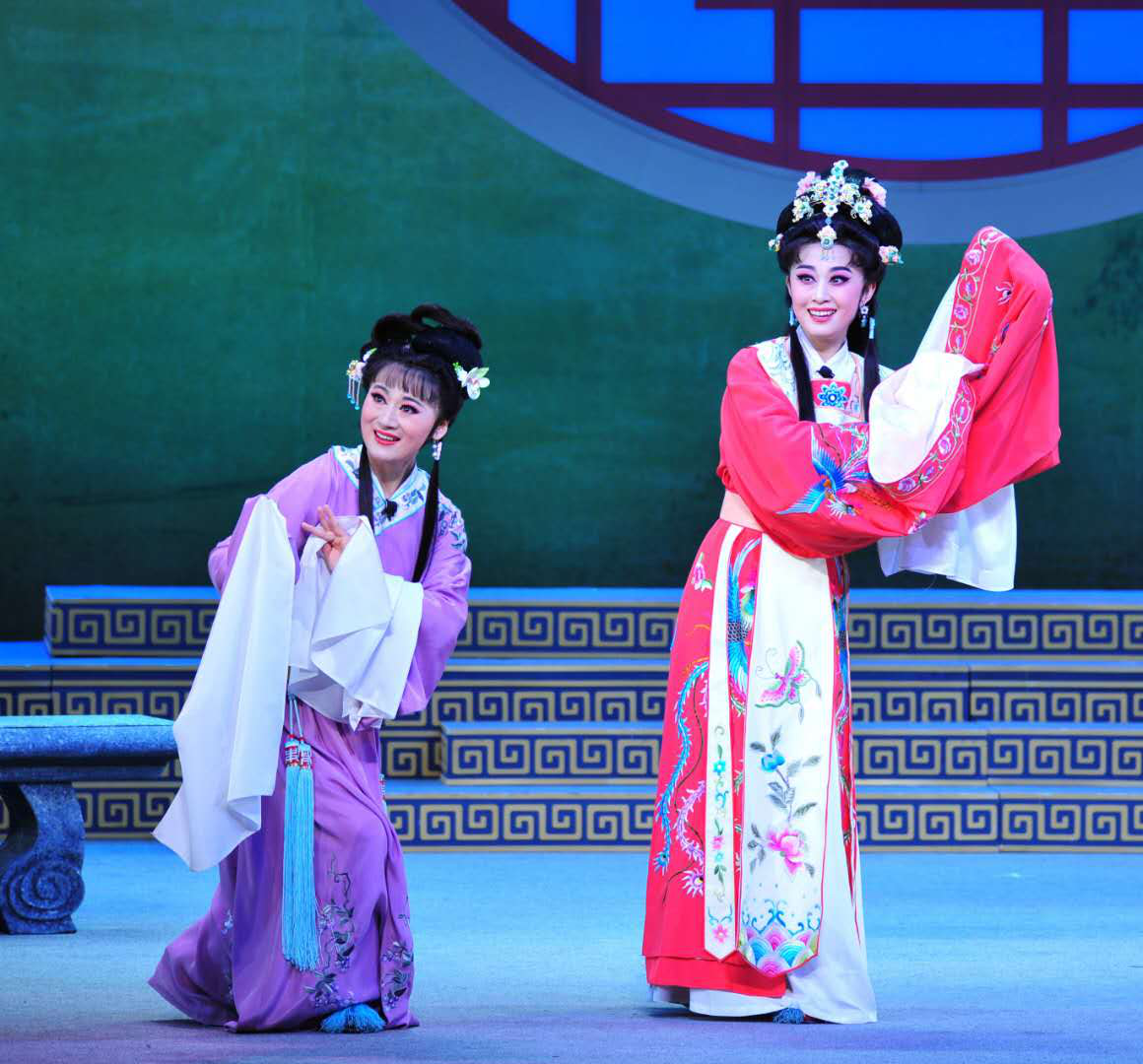
柳子戏
Liuzi Opera
柳子戏又名弦子戏,是中国戏曲古老声腔之一,流行于鲁苏豫皖冀五省交界地,因曲牌中有一种柳子调,故得名柳子戏。该戏与大弦子戏、罗子戏等同出一源且相互影响,都以三弦作为主要乐器,辅之笙、笛。其中济宁汶上一带柳子戏又吸收“汶上梆子”配乐和唱法,使柳子戏唱腔更加丰富。2006年列入《第一批国家级非物质文化遗产名录》。山东省柳子戏艺术保护传承中心(山东省柳子剧团)是全国唯一的柳子戏艺术表演团体。
Liuzi Opera, also known as “Xianzi Opera”, is an ancient genre of Chinese opera popular at the junction areas of five provinces, namely Shandong, Jiangsu, Henan, Anhui, and Hebei. It’s named after the representative tune of “Liuzi”. Sharing the same origin with Daxianzi Opera and Luozi Opera, Liuzi Opera is usually performed with the three-stringed instruments that are accompanied by a flute and a sheng (a woodwind instrument). The Liuzi Opera in Wenshang County in Jining City of Shandong Province absorbed the elements of music and tune of “Wenshang Bangzi” (Wooden Clapper Opera) that enriched the tunes of Liuzi Opera. In 2006, it was included in the First Representative List of State-Level Intangible Cultural Heritage in China. The representative plays of Shandong Liuzi Opera Art Preservation and Inheritance Center (Shandong Liuzi Opera Troupe) is the only performing art group of Liuzi Opera plays in China.
柳子戏《张飞闯辕门》
Liuzi Opera “Zhang Fei Breaking into the Military Gate”

杨家埠木版年画
The Yangjiabu Woodcut New Year Paintings
潍坊杨家埠木版年画是流传于山东省潍坊市杨家埠的一种民间版画,兴于明初,盛于清嘉庆年间,迄今已有600多年的历史,与天津杨柳青、苏州桃花坞并称为“中国三大木版年画”。它乡土气息浓郁,艺术风格淳朴鲜明,是中国民间艺术宝库中的瑰宝。2006年5月,被国务院公布为第一批国家级非物质文化遗产代表性项目。
The Yangjiabu Woodcut New Year Paintings in Weifang is a type of folk woodblock prints popular in Yangjiabu of Weifang City in Shandong Province. It emerged in the early Ming Dynasty (1368-1644) and flourished during the reign of Emperor Jiaqing (1796–1820) in the Qing Dynasty. Along with the New Year Paintings produced in Yangliuqing of Tianjian and in Taohuawu of Suzhou, they constituted the “three major woodcut New Year paintings of China”. By virtue of its rich rustic flavor and distinctive artistic style, it has been a treasure of Chinese folk art. In May 2006, it was inscribed on the list of the First Representative List of State-Level Intangible Cultural Heritage in China released by the State Council.

德州黑陶烧制技艺
Dezhou Black Pottery Craft
德州黑陶是中国黑陶的一种,其历史渊源可追溯到距今已有四千多年的新石器时代龙山文化。龙山文化时代的中国先民崇拜黑色,黑陶中的蛋壳陶为当时最高规制的祭祀用礼器。德州黑陶是一种无釉陶器,采用京杭运河两岸的红胶泥作原料,用传统的手工轮制成型,留存着大汶口文化陶器的传统轨迹。2014年列入第四批国家级非物质文化遗产代表性项目名录扩展项目名录。
Dezhou Black Pottery, as a category of Chinese black pottery, could trace its history back to the Longshan Culture during the Neolithic Age over 4,000 years ago. Back then, Chinese ancestors worshiped the black color and the black egg-shell pottery was used as the supreme sacrificial vessel. Dezhou Black Pottery is a non-glazed pottery that is made from the red clay of Beijing-Hangzhou Canal and shaped by traditional handcraft, carrying the traditional remains of the pottery in the Dawenkou Culture. In 2014, Dezhou black pottery craft was included in the Fourth Extended Representative List of State-level Intangible Cultural Heritage.

海阳大秧歌
Haiyang Yangge (folk dance)
海阳大秧歌是山东三大秧歌之一,集歌、舞、戏于一体的民间艺术形式。海阳大秧歌素以粗犷奔放、感情充沛、风趣幽默的表演风格著称于世,表演内容丰富,舞蹈动作跑扭结合,队伍结构主要由执事、乐队、秧歌剧人物或戏曲杂扮者三部分组成。海阳大秧歌是海阳地域文化的重要组成部分。
Haiyang Yangge (folk dance), one of the three Yangge forms in Shandong Province, is a folk art form that integrates music, dance and opera. Haiyang Yangge has been well-known as straightforward, unrestrained, emotional and humorous. It is performed in constantly changing forms and contents. The performance group is mainly composed of a leader, a music band and a character in the play or an opera player. It’s an integral part of the local culture in Haiyang.
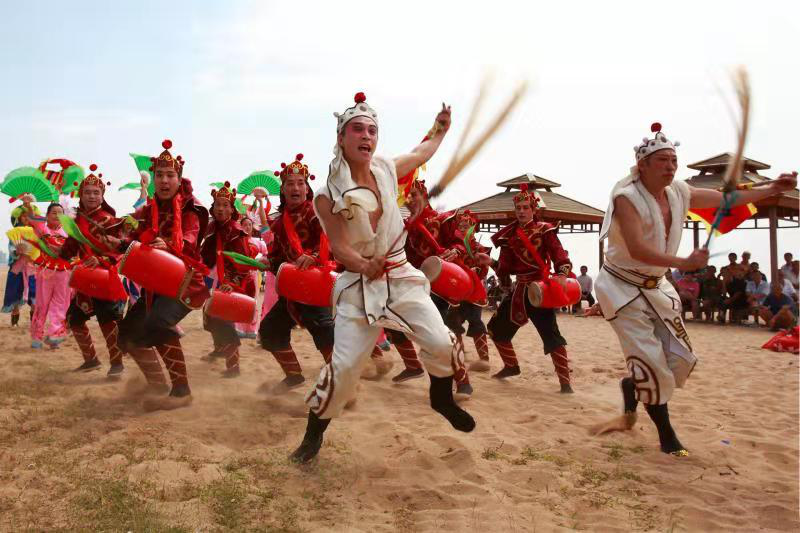
广饶齐笔制作技艺
Qi Writing Brush in Guangrao
齐笔主要分布在山东省广饶县,制作技艺起源于春秋战国时期。齐笔从选料到成笔,要经过浸、拔、梳、剔等150多道工序,具有尖、齐、圆、健四德。齐笔的成品笔锋要达到毫尖平齐,腰部刚挺有弹性;书写时则要刚柔相济,锋毫聚而不散。中国书画界盛誉齐笔“锋颖尖锐、丰硕圆满、修削整齐、健劲有力”。
Qi writing brush is mainly made in Guangrao County of Shandong Province and the craft of making the Qi writing brush originated in the Spring and Autumn Period (770–476 BC) and the Warring States Period (475–221 BC). The process of making the brush, ranging from the selection of material to the finished product, involves 150-plus steps, such as dipping, pulling, combing, and picking. Qi writing brush distinguished itself with four virtues of being “pointy, even, round, and resilient”. The brush tip should be as pointed as an awl and the brush waist or spine should be solid and resilient. While writing, it can be both solid and soft, with the hair on the brush always forming a defined and symmetrical tip. Qi writing brush has a reputation among Chinese painters and calligraphers for being “pointy, round, plump, neatly trimmed, resilient and solid”.
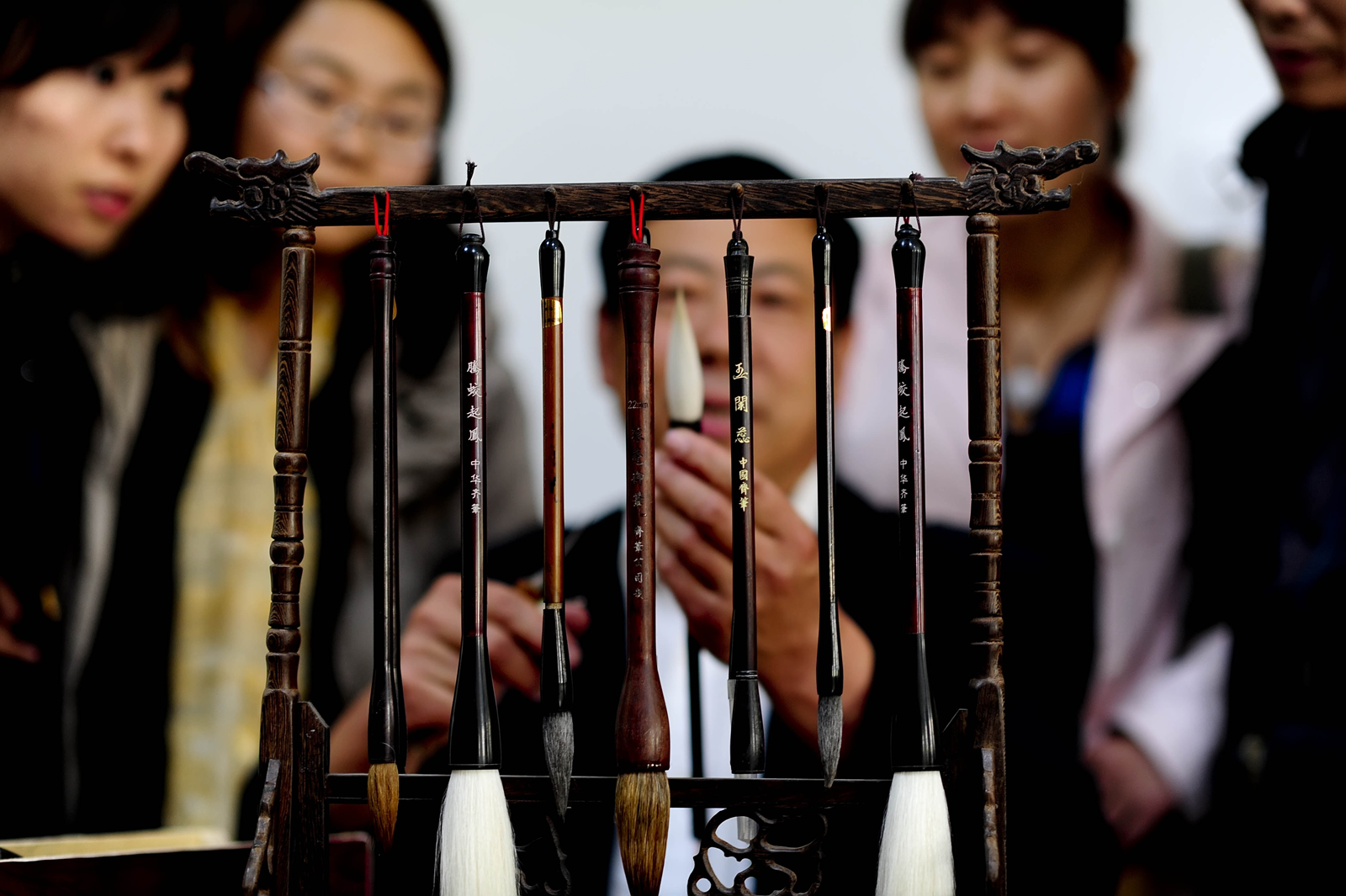
东昌葫芦雕刻
Dongchang Gourd Carving
东昌葫芦雕刻艺术风格淳朴典雅,题材广泛,技法独特,风格多样。东昌葫芦雕刻的内容主要涉及神话、民俗,其寓意与仙道、富贵、长寿、子孙繁盛等有密切相关,文化内涵丰富,是中国葫芦文化的重要组成部分。2008年6月,东昌葫芦雕刻被列入第二批国家级非物质文化遗产名录。
Dongchang gourd carving art features a simple and elegant style, a wide range of themes, unique techniques, as well as rich varieties. The content of the Dongchang gourd carving art mainly involves myths and folk customs, carrying implications that are closely related to immortals, wealth, longevity, and prosperity of descendants. Having been invested with cultural significance, it is an integral part of Chinese gourd culture. In June 2008, it was inscribed on the Second Representative List of State-Level Intangible Cultural Heritage in China.

高密剪纸
Gaomi Paper-cut
高密剪纸包括窗花、门笺、墙花、顶棚花等,它的流传同山东高密农村的节令风俗有着密切的关系。高密剪纸题材广泛内容丰富,花草虫鱼、飞禽走兽和人物皆可入剪。根据寓意可以分为纳吉、祝福、祛邪、除恶、劝勉、警戒等七类,纹样可以分为人物、鸟兽、文字等十几类,题材多取自民间传说、神话和戏曲故事。高密剪纸象征性强,造型朴实夸张,粗犷中见清秀,拙朴中藏精巧。
Gaomi paper-cuts could be seen to adorn windows, doors, walls and ceilings. The boom of the art has been closely associated with the festive customs in rural areas of Gaomi in Shandong Province. The paper could be cut into endless patterns, ranging from flowers, grass, insects, fish, birds, beasts to images of people. In terms of its uses, the paper cutting falls into seven categories for presenting betrothal gifts, giving blessings, dispelling bad omens, eliminating evils, encouragement, and caution. The patterns could be divided into a dozen of categories, such as images of people, birds and beasts, characters, and so on. The contents are largely based on folk legends, myths and opera plays. Gaomi paper-cut is symbolic of Chinese paper cutting, with simple and exaggerated design that is straightforward yet elegant, concise yet elaborate.

东明粮画
Dongming Grain Painting
东明粮画制作技艺,又名“福籽绘”,主要是巧妙利用五谷杂粮的天然形状和颜色,经过防腐防虫处理后,拼粘而成的传统民间工艺画,具有“五谷丰登、国泰民安”的美好寓意,色彩丰富、做工精细、构思巧妙,被人们称为挂在墙上的“精神食粮”。
Dongming grain painting, also known as “Fu-zi painting”, is a traditional folk craft. It mainly uses the natural colors and shapes of cereal grains after anti-corrosion and insect-proof treatment to artfully paste various auspicious patterns on wooden boards or porcelain plates to pray for a good grain harvest, prosperity for the nation and peace for the people. Such paintings are characterized by bright colors, elaborate skills and indigenous designs, which has won it the reputation of “spiritual food” hanging on the wall.
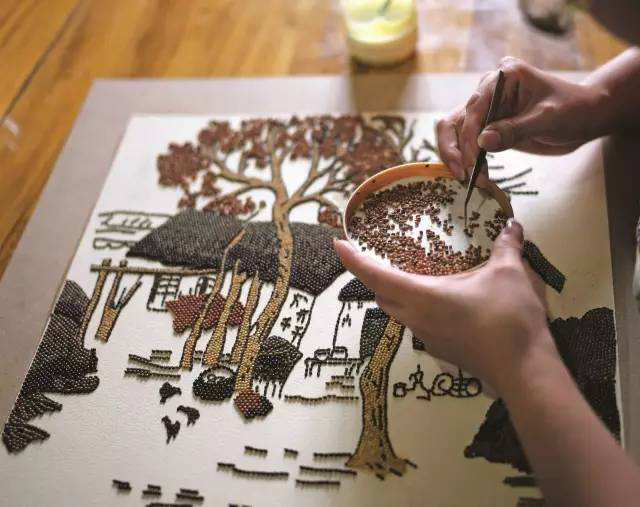
侯氏社火脸谱
Shehuo Facial Makeup of Hou Family
社火”亦称“射虎”,指古代民间祭祀或节日里迎神赛会上的各种表演。社火脸谱指人们在社火活动中,为准确扮演社火人物形象,而在面部进行的彩绘及修饰等。社火脸谱亦可脱离社火表演独立存在。侯氏社火脸谱根据社火文化的发展与当时社会历史背景,绘制出百姓喜闻乐见的“舜帝”“姜太公”等脸谱。
Shehuo, also known as “she-hu (tiger shooting)”, is a kind of folk performance originated from the sacrificial ceremonies in ancient times or the folk festival that involves shrine or image of God. Shehuo facial makeup refers to the face paintings or make-ups for the performers to make them look more like the roles they played. Shehuo facial makeup can exist independently from Shehuo performance. The Hou Family is renowned for making the facial makeup of Emperor Shun, Jiang Taigong and other images that are popular among the people, in line with the development of Shehuo culture and the actual social and historical context.
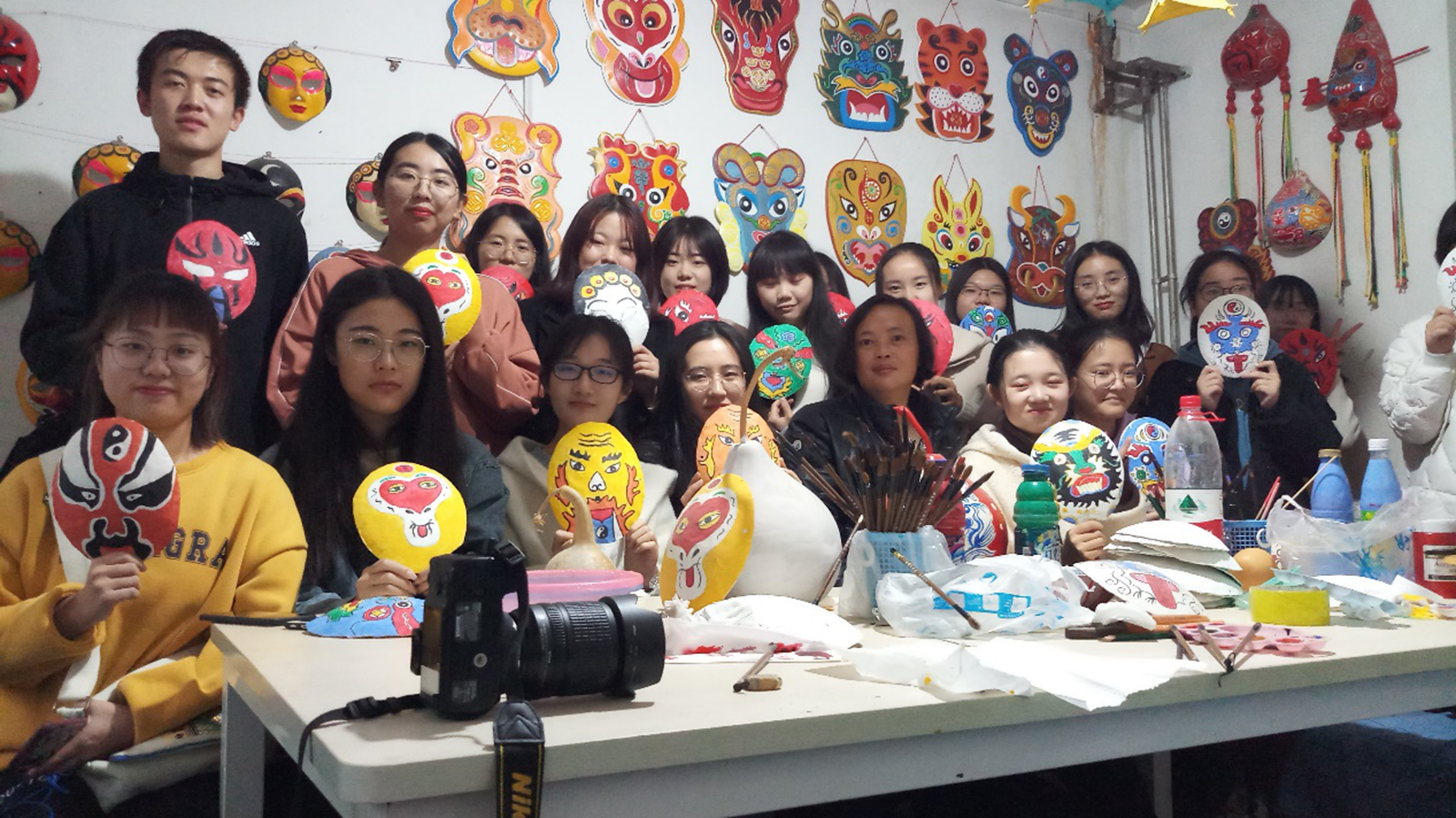
高密扑灰年画
Gaomi Ash-patting New Year Painting
高密扑灰年画亦称“民间写意画”,作画时先用柳枝烧制的炭条打好草稿,然后用毛笔勾描,再用白纸拓印,一稿可拓扑多张,“扑灰”由此得名。扑灰后的画稿还要加以手绘,经多道工序后才能成画。高密扑灰年画在发展过程中善于吸收各种绘画因素和造型风格,保存了中国民间绘画的传统技能。
Gaomi ash-patting New Year Painting is also known as “folk freehand brush work”. To make such a painting, a rubbing is made from a first draft drawn in charred sallow and delineated by a brush. Next the draft is rubbed on drawing paper, if needed, a rubbing can produce several copies of the drawings. Afterwards the drawing is hand painted and subjected to several other procedures. Over the years, Gaomi ash-patting New Year painting has absorbed various elements and styles from other types of paintings, while preserving the traditional techniques of Chinese folk paintings.
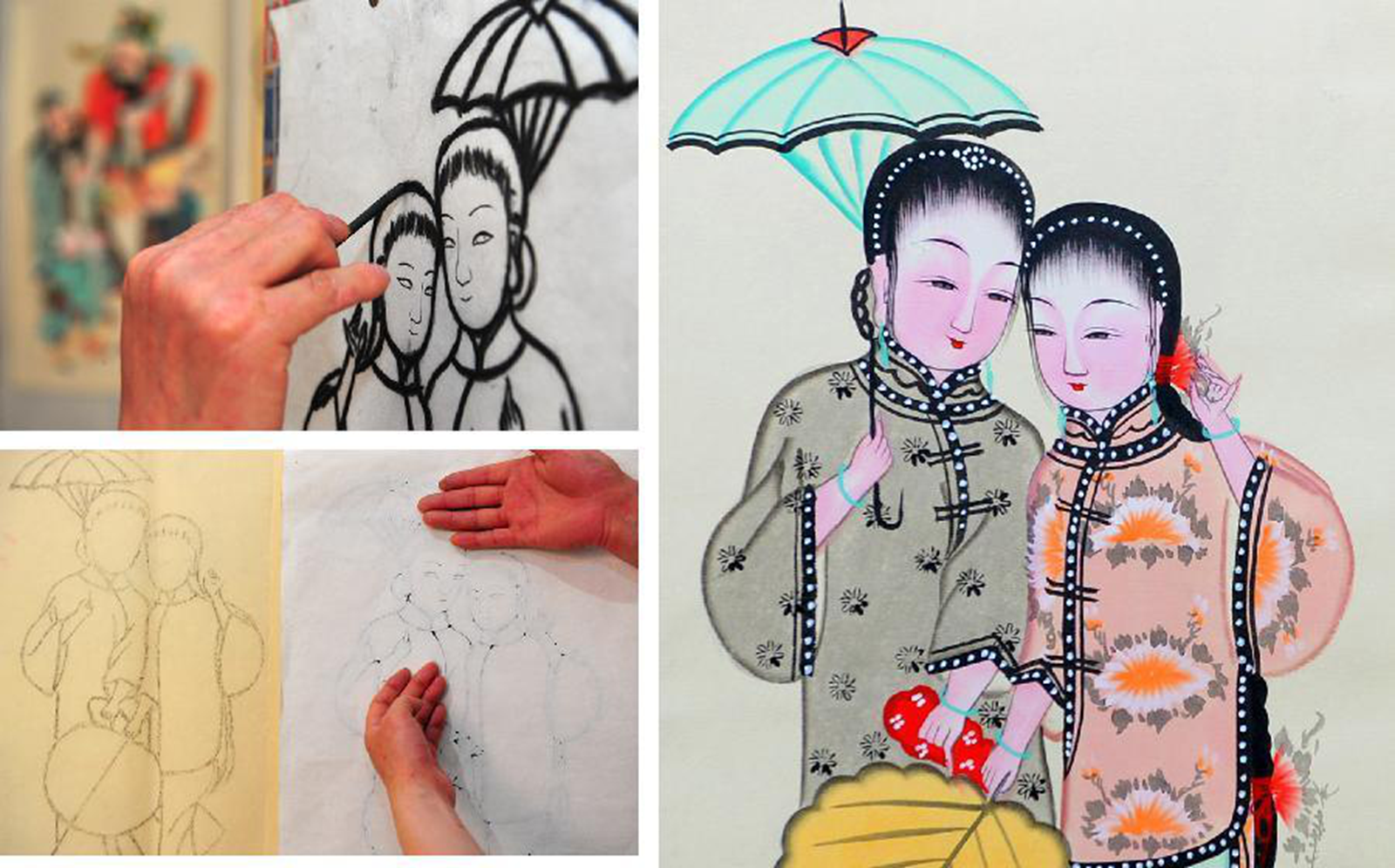
济南结艺
Chinese Knotting Art in Ji’nan
中国结艺是中国民间手工编结艺术。济南结艺的编制,大致分为基本结、变化结及组合结三大类,其编结技术,除了需熟练各种基本结的编结技巧外,均具共通的编结原理,并可归纳为基本技法与组合技法。设计一组美观大方的结饰,把自己的艺术美感和浓浓情思融注其中,便能充分表现出中国传统艺术之美。
Chinese knot is a folk hand-knotting art in China. The Chinese knots in Ji’nan can be roughly divided into three categories—the knot in basic patterns, varied patterns and combined patterns. Apart from the elementary knotting skills for basic patterns, there are some commonly-used techniques that can be summarized as basic techniques and combined techniques. To design beautiful and elegant knots for decoration, you also need to inject your own artistic ideas and strong feelings into it, so as to fully display the beauty of traditional Chinese art.
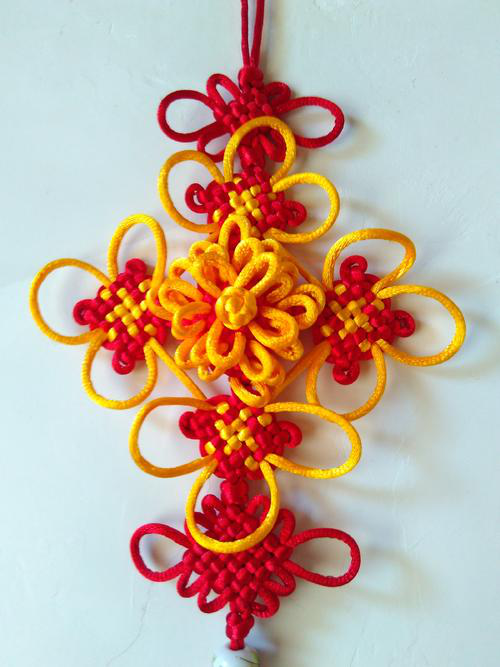
老猫花灯扎制技艺
Laomao Festive Lantern
老猫花灯扎制技艺始于明代。传统老猫花灯制作题材丰富,花鸟瑞兽造型居多,寓意吉祥。花灯制作时,用竹丝或铁丝扎制骨架,外糊彩纸或纱绢,或贴剪纸、或施彩绘,造型饱满,鲜艳生动,制作考究。
The craft of Laomao (literally meaning “old cat”) dated back to the Ming Dynasty (1368-1644). The traditional Laomao festive lanterns cover varied themes, mostly flowers, birds and auspicious animals, which conveys good wishes. To make such a lantern, you need to make a frame with bamboo or iron wire first, before proceeding to cover the frame with colored paper, thin silk, paper-cuts, or paintings. In short, the lanterns are beautifully shaped, featuring bright colors, vivid designs and exquisite appearance.

刘氏布偶
Liu Family’s Puppets for Shadow Play
“刘氏布偶”作为一种民间艺术,色彩多为红、绿、黄、蓝、紫、黑、白、金、银等对比强烈的民俗色彩,原料均为无污染的植物染料,造型采用缝绣、粘贴、手绘、等多种工艺精心制作而成,装饰多为福、寿等字样和有吉祥寓意的蝴蝶、金钱、如意等,融雕塑、剪纸、绘画于一体。
Liu Family’s puppets for shadow play, a form of Chinese folk art, features the bright colors that produce a strike contrast, such as red, green, yellow, blue, purple, black, white, gold, and silver colors from pollution-free vegetable dyes. The making of puppets involves multiple elaborate skills, such as sewing, embroidery, pasting, and hand painting. They are usually decorated with the Chinese characters of “fu” (blessings) and “shou” (longevity), or images of butterfly, gold ingot, ruyi (an S-shaped ornamental object), or other auspicious symbols, integrating carving, paper-cutting and painting.
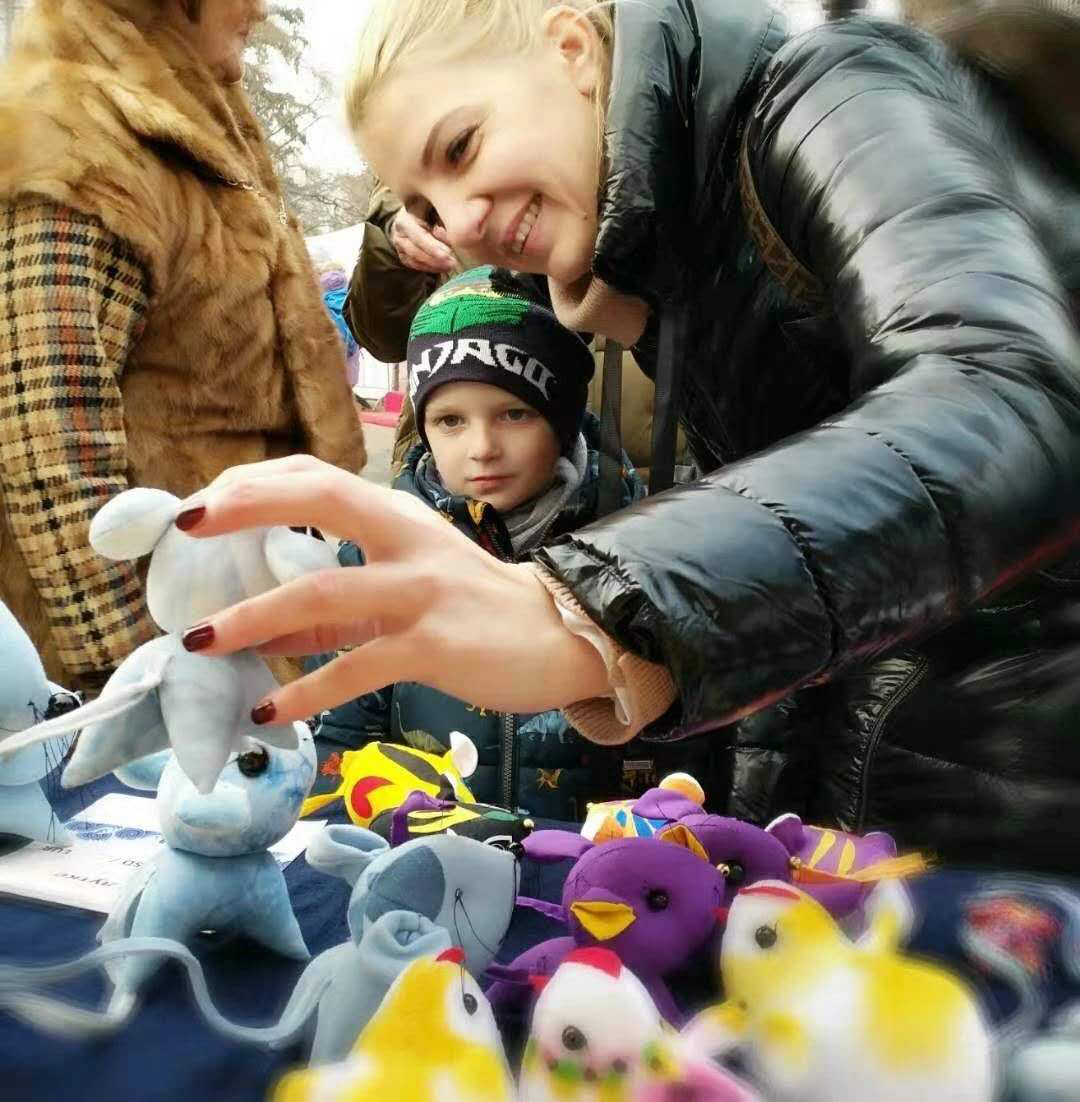
剪影
Silhouette
剪影是运用剪刀和黑色纸(或重色纸)剪制人物、动物或其它物体外轮廓的剪纸艺术形式。剪影需要敏锐的观察力,丰富的想象力,高度的摹仿力和准确的判断力。剪影时,不用临摹,不用笔画,抬眼一看,人物的特征就全部记在心里。一剪子下去,眉、眼、鼻、口棱角分明,凹凸起伏浑然天成,线条匀称流畅,仅用二十多秒的时间即可完成。
Silhouette is a form of paper-cutting art that uses scissors and black paper (or dark-colored paper) to portrait the profile of people, animals or other objects. It requires keen observation, fertile imagination, exceptional ability to imitate, and accurate judgment. To make a silhouette, there is no need for a copy or a painting brush. The artist only needs to have a look at the figure and will have all the features inscribed in his mind. Then, with a pair of scissors and non-stop cut, a silhouette with clearly outlined brows, eyes, nose and mouth will show vividly in front of you. Such a beautifully figured work full of life only takes some 20 seconds to produce.
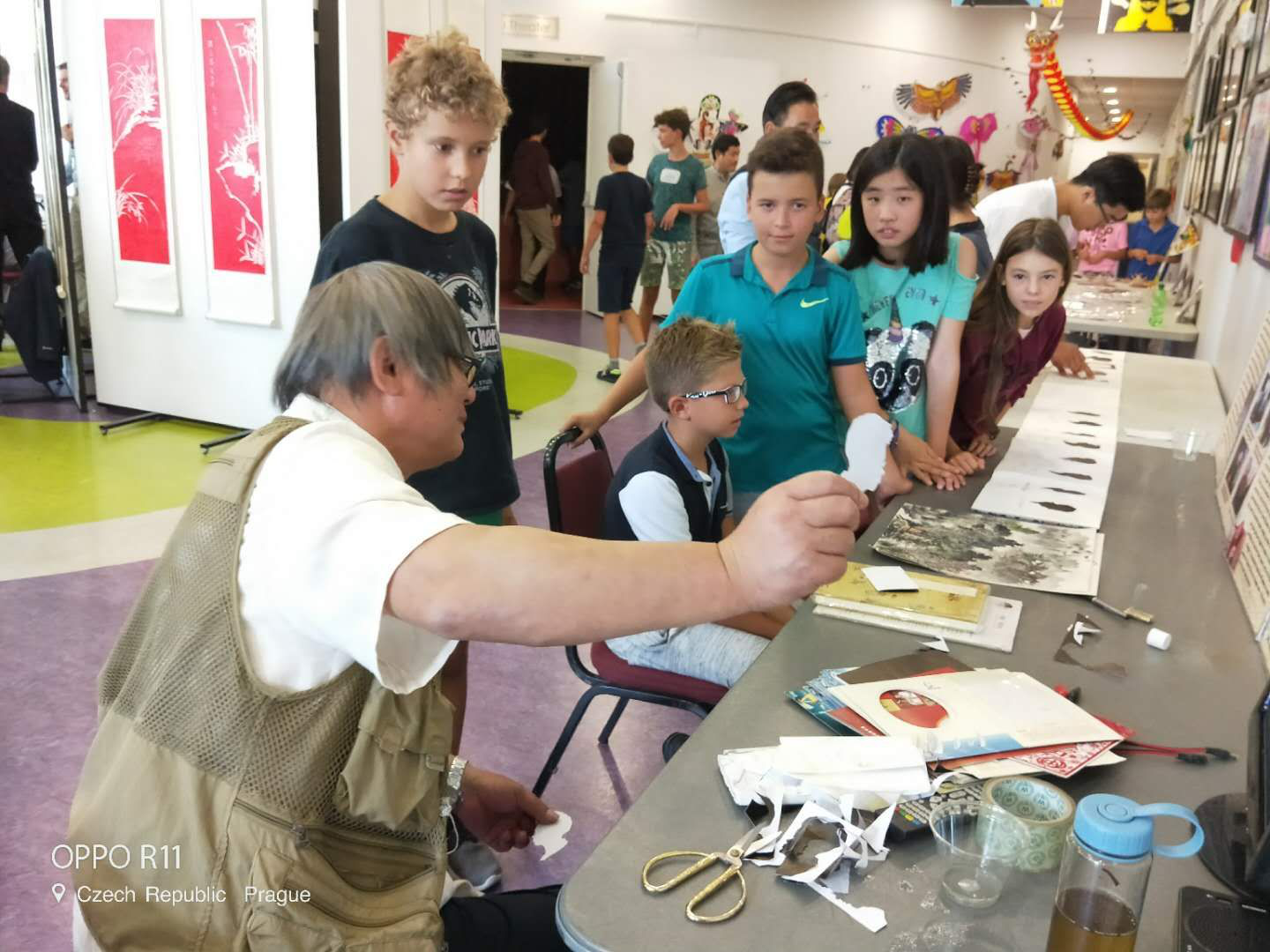
糖画
Sugar Painting
糖画,采用上等冰糖加蜂蜜经过传统工艺熬制成糖液,再经过绘画制成。糖画可分为平面糖画与立体糖画两种,题材有小说、戏曲人物、吉祥花果、飞禽、走兽、文字等,以人物和动物的造型最为有趣。糖画既可观赏,也可食用,深受小朋友及青少年的喜爱,是传统庙会、春节等喜庆节日的传统手艺。
Sugar painting is an art to paint with the liquid sugar that is made with traditional techniques from quality crystal sugar and honey. There are two types of sugar paintings: two-dimensional and three-dimensional. The subjects of sugar paintings involve characters from novels or opera plays, auspicious flowers, fruits, birds and animals, or Chinese characters, among which the ones in the images of people and animals are the most amusing. It could be appreciated as an art work or taken as a snack. Most kids and teenagers have been a fan of the sugar painting which is also a traditional craft for festivals like temple fairs and Spring Festival.

聂家庄泥塑
Niejiazhuang clay sculpture
聂家庄泥塑起源于明万历年间,至今已有400余年的历史,本是焰火的附属品,称为“锅子花”。聂家庄泥塑题材宽泛,以泥娃娃、叫虎、叫鸡、摇猴等为主,与扑灰年画、高密剪纸同称为“高密三绝”。 2008年6月,被国务院公布为第二批国家级非物质文化遗产代表性项目。
The craft of Niejiazhuang clay sculpture emerged during the reign of Emperor Wanli in the Ming Dynasty, with a history of 400-plus years. Originally as an accessory of fireworks, it is dubbed “pot flower”. There is an extensive range of subjects for the figurines, mostly dolls, tiger, chicken, and monkey. Along with ash-patting New Year painting and paper-cut, they were branded the “three most distinguished folk arts in Gaomi”. In June 2008, it was inscribed on the Second Representative List of State-Level Intangible Cultural Heritage in China released by the State Council.

蓬莱小面
Penglai noodles
蓬莱小面系蓬莱传统名吃,有着近两百年的历史。蓬莱小面由多种食材制作而成,用料考究,制作技艺工序繁琐,形成了量小、面细、汁鲜的特色。面的制作有和面、溜条、出条三大核心工序,卤的制作有底汤制作、煮鱼(野生加吉鱼)等工序。将煮熟晾凉的面条盛入碗中并浇上卤汁,蓬莱小面便制作完成了。
Penglai noodle is a traditional local delicacy dating back to almost 200 years. It is made from a variety of ingredients, exquisite materials, and complex procedures. It is characterized by limited ration, slim noodles and delicious soup. The making of noodles goes through three core procedures, namely kneading dough, making dough to strips, and turning strips to noodles. The thick gravy was made after making the soup base, cooking fish (wild snapper) and others procedures. Put the cooled cooked noodles into the bowl and then pour the thick gravy. Then, you can enjoy the Penglai noodle.
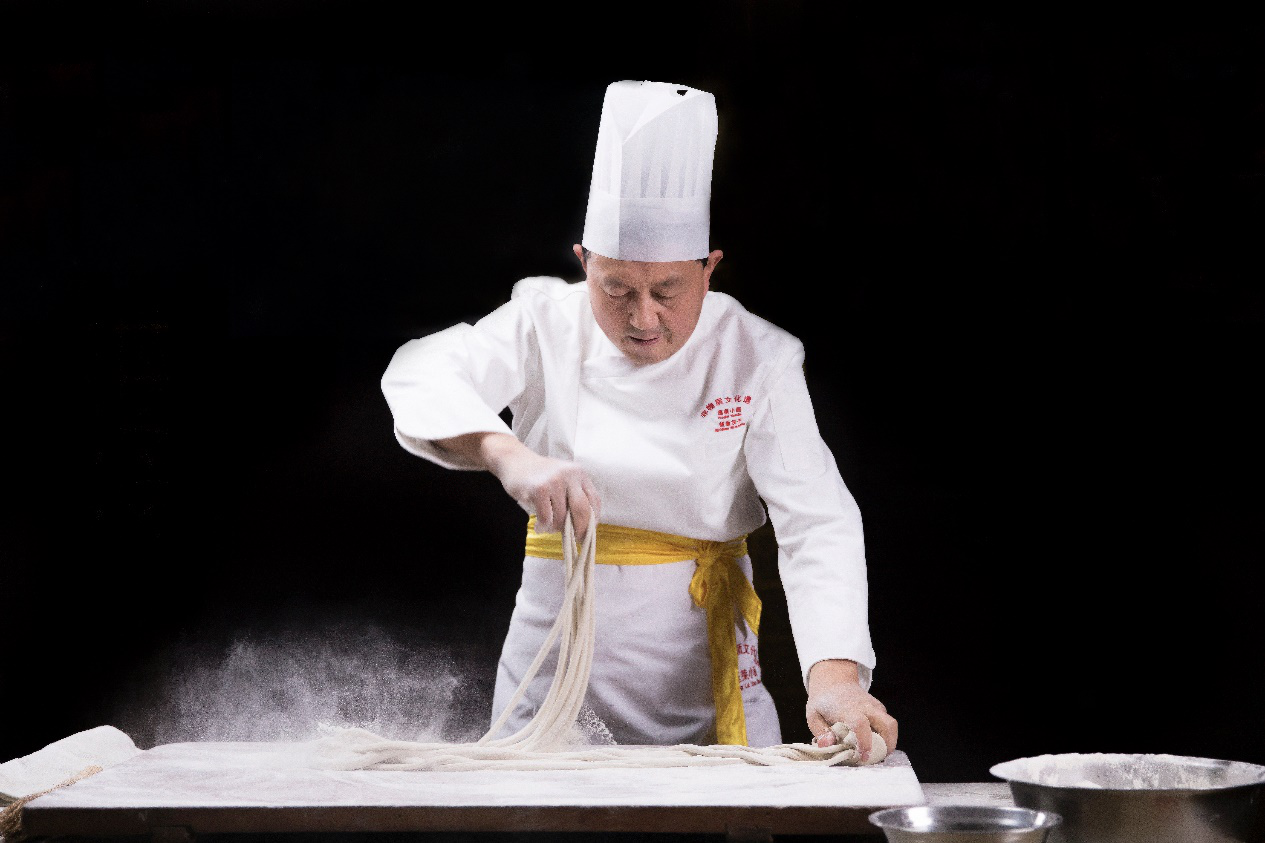
胶东花饽饽
Jiaodong Hua-Bobo
胶东花饽饽以面为加工对象,以刀、剪、笔等工具进行创作,是民间托物寄情、象征丰收喜庆、祈福长寿、自做自用的生活艺术用品。胶东花饽饽按其使用功能可分为两类:一类是专门用于观赏收藏的花饽饽,通常用精面粉、盐、防腐剂及蜂蜜等制成;另一类是可以食用的花饽饽。
Jiaodong Hua-bobo, literally flour flower, refers to flower-shaped steamed buns. It is made from the flour with tools like knife, scissors and pen. It is a folk art of life to convey feelings, celebrate harvest and festivals, pray for longevity, and serve one’s own purpose. In terms of function, Jiaodong Hua-bobo could be divided into two categories. One is for exhibit and collection, usually made from refined flour, salt, preservatives and honey. The other is edible food.
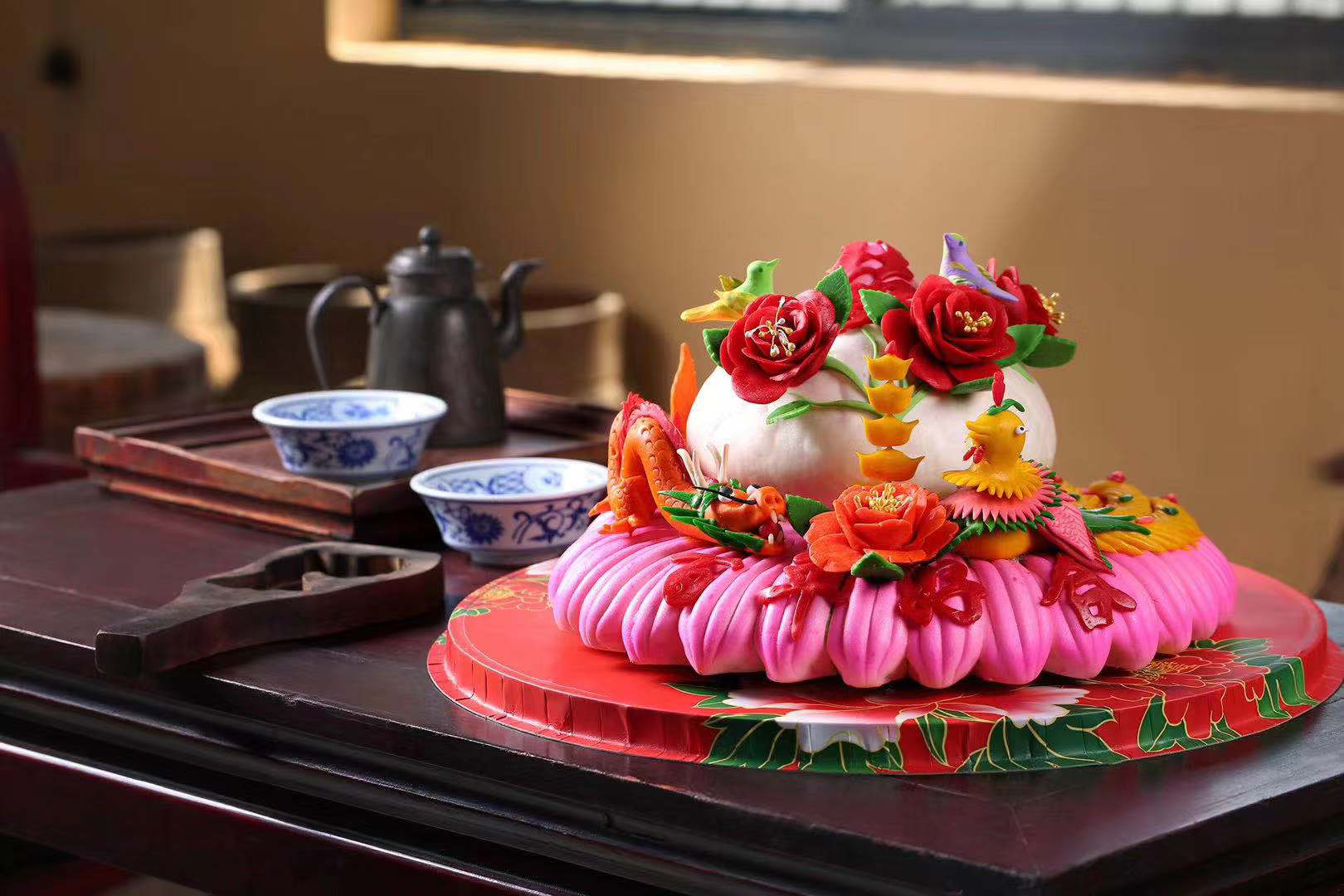
舞狮
Lion Dance
舞狮是中华民族的一门独特艺术,舞狮的表演注重表现狮子的形神兼备,调动现场观众的想象力,其起源可追溯到东汉。东明县东方舞狮属于我国“北狮”艺术范畴,通常由两头狮子或多头狮子进行表演,具有刚劲有力、洒脱奔放、形神兼备、节奏鲜明的艺术风格。
Lion dance is a unique art of the Chinese nation. The key of lion dance is to show both the body and the spirit of the lion and stimulate the imagination of the audience. The art could be traced back to the Eastern Han Dynasty. The Oriental Lion Dance in Dongming County falls under the category of “North Lion Dance”. It is usually performed by two or more “lions”, presenting a strong, powerful, free, and distinct style.

彩印花布传统印染技艺
Traditional Printing and Dyeing Techniques for Printed Fabric
山东临沂的彩印花布古朴而浓艳,主要以大红、翠绿、桃红、紫、黄等色套印,讲求“七红八绿十二蓝”,民间常以“鹅黄鸭绿鸡冠紫,鹭白鸦青鹤顶红”来形容其绚丽色彩。彩印花布题材多为牡丹、凤凰、荷花、富贵、福寿,选题独特,构图饱满,色彩艳丽,对比强烈,质朴豪放。
The printed fabric in Linyi of Shandong Province is of primitive simplicity and bright-colored, mainly in red, emerald green, pink, purple, yellow, among others. There are seven types of red color, eight types of green color and twelve types of blue color. The local people usually describe the brilliant colors as goose yellow (light yellow), duck green, cockscomb purple, egret white, crow cyan, and crane-heading red. The printed fabric largely features peony, phoenix, lotus, and others that carry the implications of prosperity and longevity. The printed fabric is unique, lively, bright-colored, and primitively simple.
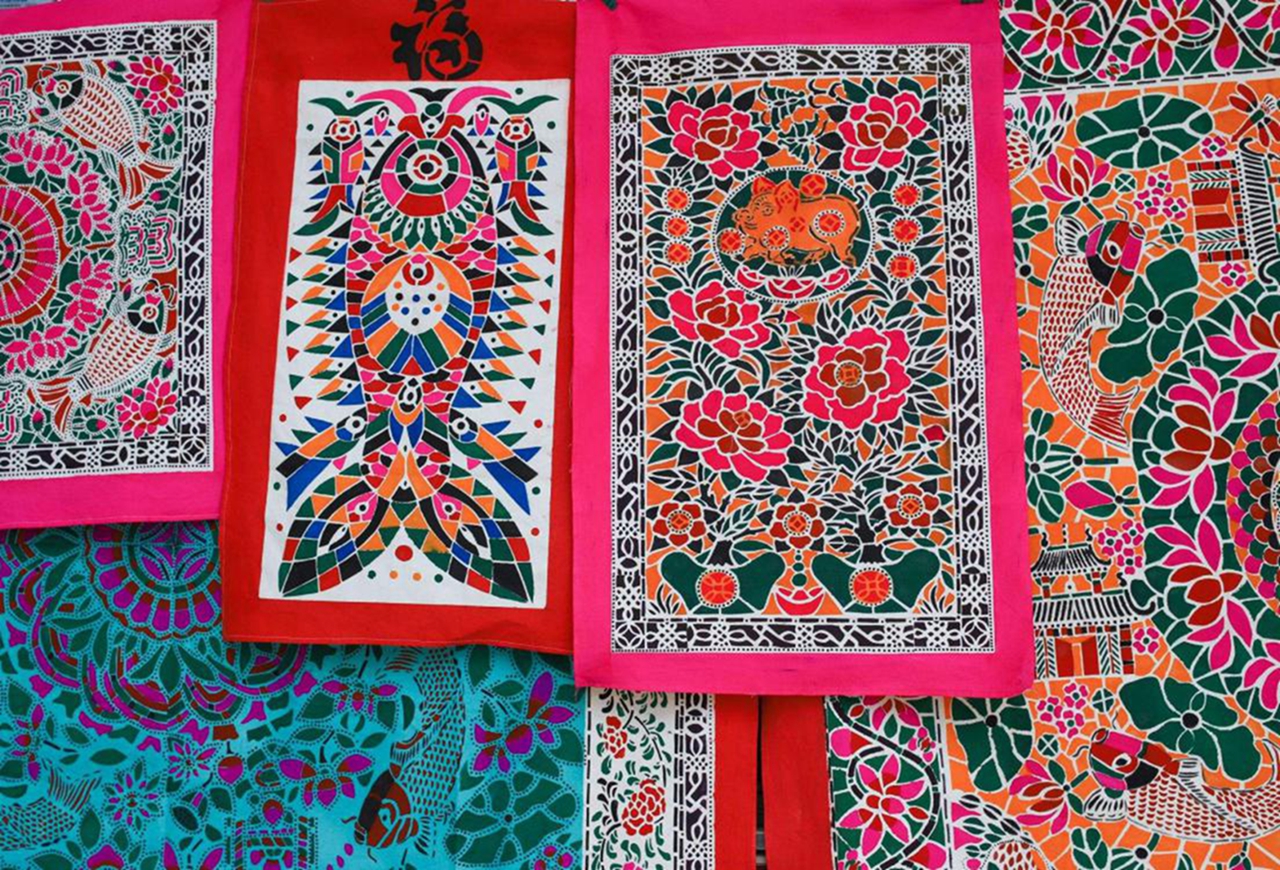
潍坊风筝制作技艺
Weifang Kite Craft
潍坊风筝兴于明初的杨家埠村。那时,村民以木版年画的刻印技术,用印年画的纸张、颜料,绘制出各种图案,扎制风筝。其扎制方法虽简单,少则竹条三根,多不超过七根,但讲究竹条均匀、骨架周正、左右对称、重心拴线,形象简练,色彩鲜艳,对比强烈。潍坊风筝具有起飞平稳、放飞高的特征。
Weifang kite was born in Yangjiabu Village in the early Ming Dynasty. At that time, the villagers made kites by applying the engraving technique for woodcut New Year paintings and drawing various patterns with the paper and dyestuff for the New Year paintings. It is easy to make the frame of the kite, requiring three to seven bamboo strips. The key is that the strips must be evenly shaped, so that the frame could be upright and symmetrical. Then, tie a string to the center of the frame. The kite looks simple and rich-colored, producing a striking contrast. Weifang kites are known for smooth takeoff and flying high.

烟台剪纸
Yantai Paper-cut
烟台剪纸包括单色剪纸、勾绘染色剪纸、拼色剪纸、衬色剪纸等,特点是剪得干净利索,形象优美生动,讲究虚实对比,并擅长用篦纹来增加色彩的浓淡层次。从传世的明代道教音乐剪纸,戚继光练兵的“盾牌舞”、“小刀舞”和明代中期表现南音演奏的剪纸来看,烟台剪纸有着悠久的历史,在中国的剪纸艺术中独具特色,久负盛名,具有深厚的历史价值和实用价值。
Yantai paper-cut features the use of single-color paper, painted and dyed paper, paper of mixed colors, and the colored paper beneath single-color paper. Yantai paper-cut is characterized by clear outline, vivid images, striking contrast, and the outstanding use of exquisite lines to enrich the layers of the colors. Judging from the famous paper-cuts about music in Taoism in the Ming Dynasty, the “Shield Dance” and “Sword Dance” in the drill ground of General Qi Jiguang, and the Nanyin Music (southern music) in the mid-Ming Dynasty, Yantai paper-cut has a long history. As a unique genre of Chinese paper-cutting art, this prestigious art has been of profound significance in history and practice.
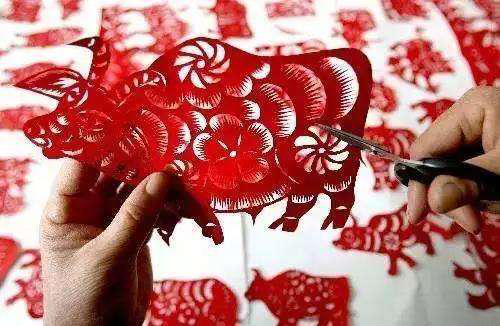
滨州民间剪纸
Binzhou Paper-cut
滨州民间剪纸广泛分布于黄河、徒骇河流域的广大乡村集镇,有着浓郁的地方特色和乡土气息,题材非常广泛,有戏曲人物、神话故事及鸟、兽、虫、鱼等。它还有不少直接反映劳动人民生活和当地民俗活动的题材。滨州民间剪纸外轮廓粗犷,内部装饰简洁,整体感强。
Binzhou paper-cut is widely distributed in the vast rural market towns along the Yellow River and Tuhai River basins. It features rich local characteristics and rustic flavors, covering a wide range of themes, such as opera characters, mythological stories, birds, beasts, insects, and fish. Sometimes, it also gives a glimpse into the lives of working people and local folklore activities. Binzhou paper-cut is known for its rough outlines, simple and clear interiors, giving a sense of wholeness.
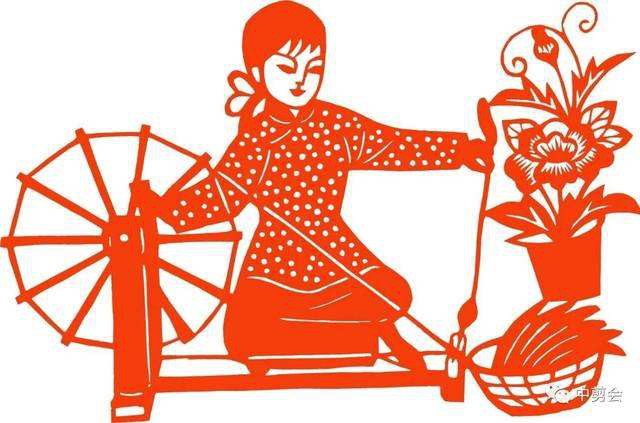
济南皮影戏
Ji’nan Shadow Play
济南皮影戏是中国皮影的一个分支,它的表演形式主要是一人操作、说唱,一人伴奏。过去的影人很小只有20厘米,后经过改良,增至50厘米甚至1米多,并加上了色彩。开始的影幕也很小,后改为2米高4米宽。唱腔吸收了五音戏、西河大鼓、山东琴书等戏曲唱腔,自然流畅、声情并茂。皮影艺人身怀绝技,一人同时操纵数个影偶,可即兴演唱,真假声转换,演奏不同乐器。
Ji’nan shadow play is a branch of Chinese shadow play. It involves two performers, one rapper who also controls the puppet characters, and the other is for accompaniment. In the past, the leather puppet was merely 20cm in height. Over time, it is increased to 50cm or even one meter, and it began to have colors. The small screen has also been expanded to the size of 2 meters high and 4 meters wide. The shadow show gradually absorbed the tunes of operas like Wuyin Opera, Xihe Dagu (a folk art form in Hebei), Shandong Qinshu and others, producing a pleasant sound. The shadow players possess remarkable skills to control multiple puppets simultaneously, give impromptu performance, switch between voice and falsetto, and play different instruments.

泰山皮影戏
Mount Taishan Shadow Play
泰山皮影戏是泰山文化的重要组成部分,人物形象往往取材于泰山民间剪纸和传统戏曲脸谱。皮影人物的行当基本与戏曲行当相同,影人的高低约在50公分左右,具有丰富而独特的唱腔体系。泰山皮影戏的剧目非常丰富,尤以《泰山石敢当》系列剧最为著名。泰山皮影戏演出无剧本,完全靠演员的记忆,属典型的口传民间文化内容。
Mount Taishan shadow play constitutes an integral part of Taishan culture. The characters are often based on the Taishan folk paper-cuts and traditional opera facial makeup. The types of roles for puppets are basically the same with that in opera. The puppets are about 50cm high. The shadow play boasts a rich and unique tune system. The repertoire of Taishan shadow play is extensive, among which the series of Taishan Shi-Gan-Dang is the most famous. Mount Taishan Shadow Play has no script and the performers must remember the stories that are passed down from generation to generation orally.
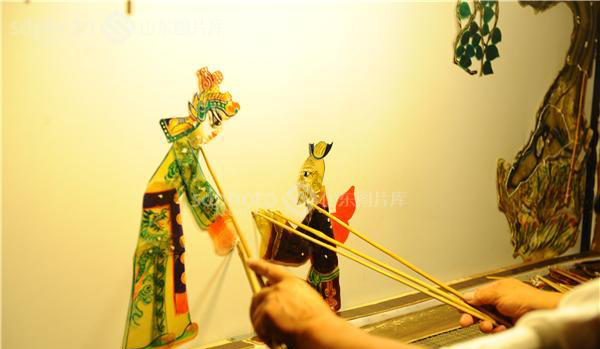
亲爱的朋友们!2020年中国山东省要在全球招募2万名“孔子旅游使者”,欢迎大家一起来了解“孔子家乡·好客山东”。
Dear friends, Shandong is to recruit 20,000 “Confucius Tourism Representatives” from all around the world. Join us to know about “Friendly Shandong, the home of Confucius”.
山东是一个文明现代、山川壮丽、历史悠久、人文荟萃的地方,位于中国东部沿海、黄河下游,与韩国、日本隔海相望,地处“一带一路”东端交汇点,曾诞生过孔子、孟子、曾子、子思以及墨子、孙子等一批中国思想文化巨人,GDP位居中国第三,人口超过1亿。
Shandong boasts modern civilization, magnificent mountains and rivers, time-honored history and a galaxy of talents. It is located on the eastern coast of China, at the lower reaches of the Yellow River, across the sea from South Korea and Japan, and at the juncture of the eastern section of “Belt and Road”. It’s the birthplace of a group of thinkers and contributors to Chinese culture, such as Confucius, Mencius, Zengzi, Zisi, Mozi, and Sunzi. Shandong has the third highest GDP in China, with a population of over 100 million.
我们期待在“孔子家乡·好客山东”与你相遇!
We look forward to meeting you in Shandong.
扫描文末二维码关注“孔子旅游使者”官方微信公众号,及时了解更多活动信息!
To keep updated about the event, please scan the QR code below to follow the official WeChat account of “Confucius Tourism Representative”.
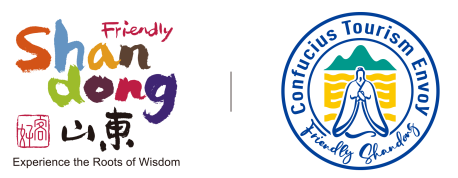
山东省文化和旅游厅
点击关注孔子旅游使者微信公众号
获取最新活动相关信息
Click here to follow the official WeChat account of Confucius Tourism Representative to keep updated about the event.





